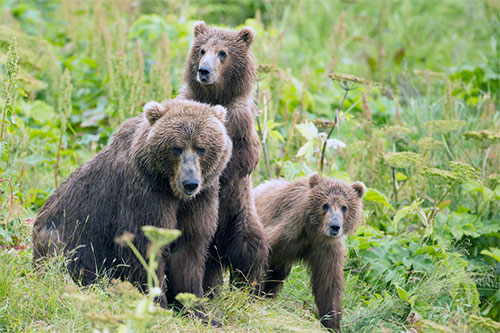
Final Rule: Predator Control Restricted on Alaska National Wildlife Refuges
August 03, 2016
Kodiak National Wildlife Refuge: Brown bear and cubs
Under the Alaska National Interest Lands Conservation Act (ANILCA), all refuges in Alaska are mandated to provide the opportunity for continued subsistence use by rural Alaska residents in a manner consistent with the conservation of natural diversity. The final rule will not change federal subsistence regulations or restrict taking of fish or wildlife under them. The state of Alaska regulates general hunting and trapping of wildlife, including on national wildlife refuges. “Whenever possible, we prefer to defer to the state of Alaska on regulation of general hunting and trapping of wildlife on national wildlife refuges unless by doing so we are out of compliance with federal law and policy,” Ashe continued. “This regulation ensures we comply with our mandates and obligations.” The rule will help facilitate the ability of the USF&W Service to maintain sustainable populations of bears, wolves and coyotes throughout national wildlife refuges across Alaska and will ensure a consistent and transparent approach to management of predators. Today in a prepared statement from Kenai, Alaska Congressman Don Young (R-AK) condemned the final rule regarding wildlife management practices upon federal refuges within the State of Alaska. “Make no mistake – the size, scope and impact of this rule is enormous,” said Young. “With over 76.8 million acres of wildlife refuges in Alaska – an area equaling the size of New Mexico – this unilateral power grab fundamentally alters Alaska’s authority to manage wildlife across all areas of our state. Not only does this rule undermine promises made in the Alaska Statehood Compact, it violates the law by ignoring provisions Senator Stevens and I secured within the Alaska National Interest Lands Claims Act (ANILCA) to protect Alaska’s sovereignty and management authority. This newest attempt to exert federal authority over Alaska has not gone unchallenged and I will continue to work every angle in Congress to strike this rule, and a similar proposal by the National Park Service, from the federal register. If this rule is allowed to stand, we could see an opening for future jurisdictional takings by the federal government – transforming a cooperative relationship between Alaska and the Fish and Wildlife Service to one of servitude.” Alaska’s national wildlife refuges encompass some of the largest and most remote wildlife habitats remaining in the United States. These vast areas are ideal for wide-ranging and large animals like wolves and bears. According to a statement on the Defenders of Wildlife's website's blog, "Anti-wildlife representatives in Congress and Alaska’s state government have been fighting this rule since it was first proposed in January, and will surely continue to do so. We commend the Fish and Wildlife Service for finalizing this important rule, which upholds bedrock environmental laws like the National Wildlife Refuge System Improvement Act and the Wilderness Act. This action sends a clear message that science, not politics, governs our public lands." The rule forbids certain aggressive hunting practices like aerial gunning, trapping bears, killing mother bears and cubs, and killing denning wolves with pups. These tactics have no place on the 16 federally protected wildlife refuges in Alaska, which exist first and foremost to conserve species in their natural diversity Defenders of Wildlife's on their website's blog. The final regulations were published by the USFW Service as a proposed rule and were open for a 90-day public comment period between January 8, 2016, and April 7, 2016. The rule was modified in response to written public comments and testimony provided at public hearings. A table showing the changes that were made between the proposed and final rule and the Service’s responses to all substantive comments can be found in the final rule. The new regulations will become effective on September 6, 2016, 30 days after publication in the Federal Register. The final rule will be available for public inspection on August 4, 2016 and will publish in the federal register Friday, August 5, 2016. Website links on those respective days. However, the draft final rule is available for review.
On the Web:
Reporting & Editing by Mary Kauffman, SitNews
Source of News:
Representations of fact and opinions in comments posted are solely those of the individual posters and do not represent the opinions of Sitnews.
|
|||

